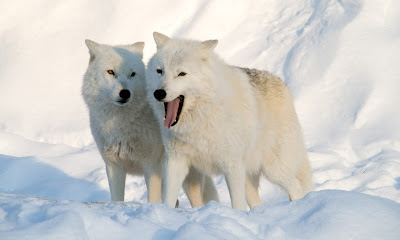 Arctic Wolf is a subspecies of the grey wolf. Grown-up Arctic wolves are between 25 and 31 inches in tallness and achieve weights of up to 175 pounds. Females have a tendency to be littler and lighter than guys. They measure between 3 and 5 feet from head to tail. Their thick cover is off-white. Ice wolves live in assemblies of 7 to 10 people. Sporadically, Arctic wolves shape gatherings of bigger numbers.
Arctic Wolf is a subspecies of the grey wolf. Grown-up Arctic wolves are between 25 and 31 inches in tallness and achieve weights of up to 175 pounds. Females have a tendency to be littler and lighter than guys. They measure between 3 and 5 feet from head to tail. Their thick cover is off-white. Ice wolves live in assemblies of 7 to 10 people. Sporadically, Arctic wolves shape gatherings of bigger numbers.
The Arctic wolf, or the cold wolf, lives in the most uncongenial environment of the planet the high ice. The latitudinal extend of their common living space grows from 70°n and higher. Then again, in light of the fact that they venture out miles and miles to search for nourishment. They have a thick white hide that keeps them warm, as well as helps them disguise in the snow while chasing. This regular layer permits them to doze agreeably indeed, when the temperature is "20 underneath", as per Animal Planet.
The Arctic Wolf is an exceedingly versatile creature. It must be, as it occupies a percentage of the most dangerous territory on earth. The air temperature in its chasing grounds does not climb above-30 degrees Celsius in April, and this consolidates with wind chill to reason temperatures of-100 degrees Celsius or less. The ground is once in a while unfrozen, and when a defrost happens, it influences just the top not many centimetres of soil. As the dirt is unfortunate, nourishment for herbivores is likewise restricted, and as the winter comes, the wolf's prey, extensive slow eaters, for example musk bull and caribou are determined south to search out better sustenance.
The Arctic wolf occupies the Canadian Arctic and the islands, parts of Alaska and northern parts of Greenland. Their environment broadens from 70° North scope and higher. They have existed in North America for more than two million years. At the time they discover a cave, they make a few chambers for nourishment and junior. The ice wolf is the main subspecies of the Gray Wolf that still might be discovered over the entire of its unique reach, generally in light of the fact that, in their characteristic living space, they infrequently experience people.
Like all wolves, Arctic wolves chase in packs, preying for the most part on caribou and muskoxen, additionally cold rabbits, seals, ptarmigan, lemmings, and more modest creatures, for example waterfowl. Because of the lack of prey, they meander expansive territories, up to 2,600 km2 (1,000 sq mi), and accompany moving caribou south throughout the winter, for a nourishment source. They are not quick runners, rather depending on stamina to bring down prey.
Arctic Wolves
The Arctic Wolf
Arctic Wolf
Wild Arctic Wolf








They are so cute and ciuld you add mor facts about them I love animals and you are crappie
ReplyDelete